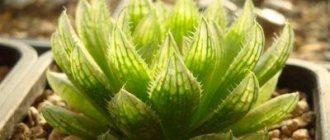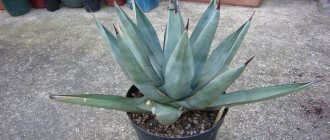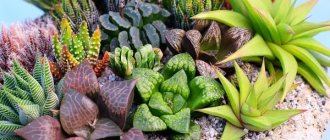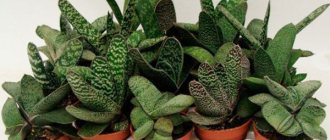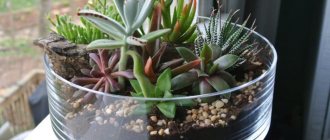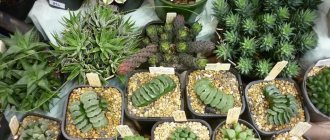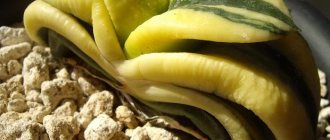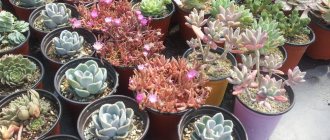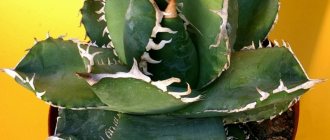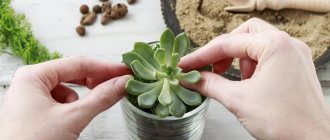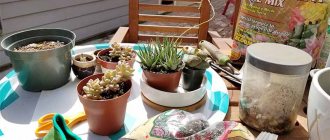Indoor plants are used to decorate the interior. However, among them there are many that, in addition to aesthetic pleasure, also bring benefits, because have medicinal properties. Such plants purify the air in the apartment, killing germs, and infusions and lotions based on them treat many diseases.
When using medicinal plants, you need to remember that they all have contraindications, so before using them you should definitely consult a doctor.
Descriptions and photographs of plants similar to aloe
A characteristic feature of aloe-like plants is their fleshy, elongated leaves, collected in a dense rosette.
Agave
Agave is a stemless perennial from the Asparagus family native to Mexico, North and Central America. Agave leaves are large, fleshy, widened or narrowed, forming a dense rosette. A hard point is formed at the ends. Most species are equipped with straight or curved spines along the edge.
The color of agave leaves is grayish, green or bluish-green. The leaves of some agave species are decorated with yellow or silvery-white thread-like stripes. The surface of the leaf plate is covered with a rich waxy coating.
Under natural conditions, agave blooms once every 10-15 years. A spike-shaped or paniculate inflorescence with many yellowish flowers is formed on a high peduncle. After flowering, the plant begins to age sharply and soon dies.
Hehtia
Hechtia is a terrestrial bromeliad, close to succulent plants. Hechtia is native to Central America and Mexico. Hechtia Texasa is similar to aloe. Its leaves are long, fleshy, pointed, hard, notched along the edges, with sparse spines. The leaves form a dense, dense rosette with a diameter of about 50 centimeters.
Hechtia blooms inconspicuously: small flowers of white, greenish, pink or red-burgundy colors are collected in small spikelets.
Bergeranthus
Bergeranthus is a plant that is not very common in our country, and mostly true lovers and connoisseurs of succulents are familiar with it. Bergeranthus is native to South Africa. Under natural conditions, this succulent forms clumps that stretch for many kilometers.
Of the 12 plant species, two are grown indoors:
- Bergeranthus polycapita. The leaves of this species are smooth, collected in rosettes of up to 10 pieces each, tightly pressed to each other. The shape of the leaves is an elongated triangular prism 6 centimeters in length, pointed at the end. The plant blooms with yellow, single flowers with a diameter of 3 centimeters.
- Bergeranthus arrowhead. The leaves are dark green. evenly colored. about 10-12 centimeters in length, wide at the bottom and tapering at the ends, 10 centimeters in length. There are serrations along the edge of the leaf. The flowers are orange-yellow, on long stalks like a cactus.
Ariocarpus
Ariocarpus is a cactus with leaves resembling aloe. The plant mainly lives in Mexico, where it thrives during the rainy season and hides in the soil during periods of drought. It is distinguished from cacti by its very unconventional appearance.
Ariocarpus is a thornless cactus. The fleshy, triangular-shaped leaves are covered with warty bumps and projections. The surface of the leaves looks like reptile skin. In nature, Ariocarpus blooms with large flowers of red, white or yellow. At home, flowering is extremely rare.
Sansevieria
Sansevieria is a stemless perennial of the agave family native to Africa. India, Indonesia and other Asian countries. This plant, popular in indoor floriculture, is also called “pike tail” or “mother-in-law’s tongue.”
Sansevieria is a plant with succulent, dark green, lanceolate-shaped leaves that form a dense, dense rosette. Powerful leaves grow up to 120 centimeters in height. Depending on the variety, the leaves of the plant are complemented by contrasting edging or vertical and horizontal stripes of a darker tone.
Faucaria
Faucaria is a succulent from the Aziz family native to South Africa. Translated from Latin, the name of the plant is translated as “mouth” (“faux”) and “many” (“αρι”).
The plant received this name because of the shape of the leaves, which are equipped with sharp white growths along the edges, similar to the teeth of a predator. The leaves are collected in rounded rosettes. Each rosette consists of 3-6 pairs of leaves growing crosswise.
Faucaria blooms with single flowers with a diameter of 6-7 centimeters. The thin petals of the flowers are painted in various shades of yellow. Flowers are open only during the day, and at night they fold their petals, turning into a bud. Each flower lives on the plant for about a week.
Gasteria
Gasteria is a succulent of the Asphodelaceae family native to the deserts of South Africa. Gasteria leaves are shortened, fleshy, dark green with a slight waxy coating. Brown or silver stripes run across the leaves. There are species with white specks that densely cover the leaves.
Gasteria blooms with flowers of medium size (2-2.5 cm in diameter) and pink flowers. Orange, white or red color. Flowers are collected in racemes or panicles formed on an oblong peduncle.
Haworthia
Haworthia is an unusually beautiful plant from the steppes and deserts of South Africa. There are more than 150 species of Haworthia, differing in appearance and leaf color: blunt and fleshy, sharp and thin, covered with small spines, yellow, silvery stripes or white pimples that look like raised warts.
The leaves of the plant form a symmetrical, beautiful rosette with a diameter of up to 30 centimeters. The leaves grow very densely. Haworthia is similar to an aloe or miniature agave. When grown at home, the plant almost never blooms.
Landing
Flower propagation must begin at the very beginning of spring. It is during this period that the plant begins to emerge from winter sleep. Therefore, vital processes begin to be activated in it, which have a beneficial effect on the development of roots. Right now it is ready to adapt to new conditions.
To plant a plant, select a container. The plant is unpretentious to containers, but it is preferable to choose a ceramic pot for growing a succulent. A clay analogue will not work, since such a product will absorb all the moisture from the soil. When the container is prepared, a high layer of drainage is poured into it. It is necessary in order to prevent moisture stagnation.
A few pebbles can be left to secure the aloe, because over time it can fall to the side under the weight of its weight. After a drainage layer is placed in the pot, it is filled with soil. In order for the succulent to take root faster, soil can be purchased at a specialty store, choosing the option for growing aloe. If this is not available, prepare the mixture yourself.
To do this, mix coarse sand, humus, expanded clay gravel, perlite and deciduous soil. The components are taken in identical proportions and placed on a drainage layer. First, a layer of mixed soil is sprinkled over the pebbles, followed by sand. Peat is not used for planting aloe vera. After preparing the soil, plant the plant.
It is necessary to take ripened seeds for planting, planting them in prepared containers. When the sprouts sprout and get stronger, they can be transplanted into other containers with identical soil composition.
Aloe-like flower
Aloe is the common name for succulent (water-storing) plants belonging to the family Asphodelaceae or Liliaceae. Aloe is characterized by fleshy, succulent leaves. Most plants have thick and soft spines.
The plants are distributed mainly in Africa, namely in South Africa, Madagascar, the Mascarene Islands, and the southern part of the Arabian Peninsula.
There are about 400 species of aloe. Many species of this plant are unpretentious and get along well at home. Also, almost all types of aloe are well suited for growing in winter gardens and take root well next to other plants, which allows them to be used in various plant compositions.
The most hardy, but whimsical. Amazing succulents
Homemade aloe vera flower: the benefits and harms of succulents
Succulents include a wide group of plants, and it's not just the cacti that come to mind most often. Succulent crops are represented by a variety of species that are not related to each other. What unites them is their original living conditions. In nature, these plants exist in arid environments, so they are forced to create a supply of moisture in thickened stems or fleshy leaves.
Would you like to receive newsletters about current treatments and seasonal garden care recommendations just in time?
Subscribe to my newsletter here . And download a booklet with recommendations for autumn care!
Growing and caring for aloe at home
Location
Aloe, like almost all succulents, prefer sunny places in the apartment, for example, south-east and south-west windows. However, direct sunlight all day long (if the aloe is located, for example, on the south window of an apartment) can harm the plant, so in this case the plant must be protected from the sun.
Humidity, watering and temperature
Aloe is not fussy regarding air humidity and can easily tolerate dry air, because the plant’s homeland is Africa. However, fresh, not stagnant air is very important for aloe. That is why it is necessary to frequently ventilate the room in which the plant is located.
From spring to about mid-autumn, the aloe watering schedule is 1-2 times a week. In winter, reduce the amount of water and water the plant 1-2 times a month. It is important to ensure that the earthen ball dries out between waterings and that the water does not stagnate in the tray.
Aloe is not picky about air temperature and microclimate. The plant easily tolerates average summer and winter temperatures in city apartments.
Transplantation and fertilization
Frequency of aloe replanting: for young plants every year, for adults - as needed, on average every 2-3 years. Aloe is planted in ready-made soil for cacti and succulents; it is also possible to prepare the soil for the plant yourself - 2 parts turf, 1 part sand, 1 part humus, 1 part leaf soil plus a small amount of charcoal. Aloe can also be grown hydroponically.
It is necessary to fertilize the plant in the summer during the period of development and growth once a month. In winter, during the dormant period, fertilizers should not be used. There are special fertilizers for succulents that are also recommended for aloe. In addition, it is possible to use complex mineral fertilizers. Fertilizers should only be applied to moist soil.
Reproduction
Aloe can be propagated in three ways: seeds, shoots from the root, stem and apical cuttings.
Since aloe blooms quite rarely, propagation by seeds is not the most common method. However. If you managed to collect the seeds of the plant, plant them in soil consisting of leaf soil, turf soil and sand. The period for planting seeds is February, March. After a year, the grown plants can be planted in separate bowls.
Propagation by cuttings is the most well-known method. The shoots of the plant must be divided into pieces of 10-15 cm and allowed to dry for several days (cuts of the shoots are sprinkled with finely crushed charcoal). The cuttings are planted in sandy soil at a distance of about 4 cm from each other and 1 cm deep. It is necessary to water the cuttings moderately, without over-wetting the sand. A week after the roots appear, the cuttings are planted in shallow bowls in ordinary soil.
Similar to propagation by cuttings and propagation by shoots. The cuttings also need to be dried before planting for two to three days, and then planted in moistened sand. If roots appear, the cuttings can be transplanted into the ground.
Pests
Aloe is usually not susceptible to disease, and pests appear on the plant just as rarely.
However, sometimes scale insects, small insects that look like a turtle shell, may appear on aloe. In this case, the folk method of fighting scale insects will help - crushed garlic with the addition of soap and water. The leaves of the plant need to be wiped with this paste several times a week.
Aloe is not only one of the most beautiful ornamental plants, it is also a real home doctor who can treat a wide variety of diseases. And what could be better when beauty is combined with benefit?
Roofing rejuvenated
Few people know that rejuvenation, an evergreen groundcover perennial that can be grown both in open ground and indoors, also has medicinal properties. The juice of the leaves of the plant has antipyretic and bactericidal properties. They treat thermal burns, apply to insect bites and inflamed skin.
When breeding young at home, some nuances should be taken into account. The plant has a small root system, so it is better to grow it in shallow containers. Juvenile does not like waterlogging - it is recommended to water it through a tray. The plant does not tolerate high temperatures in the room. But he needs a lot of sunlight. Another feature of the plant is that it likes poor soils. In rich soil, the leaves become pale green, and the rosettes disappear altogether over time.
Varieties of aloe: types of medicinal and ornamental aloe
Aloe is a popular perennial of the Asphodelaceae family. Popularly, the plant is often called Agave due to its rare and short flowering. The flower gained great popularity due to its great decorativeness and unpretentiousness.
Like other succulents, aloe can go without water for a long time and grow in the most unfavorable conditions. In total, about 400 varieties of this interesting flower are known. In this article we will look at popular types of aloe and their medicinal properties.
Reproduction
Reproduction of senecio is considered as simple as caring for a flower. There are three methods available for this: cuttings, seeds and layering.
Seeds
The method is rarely used due to the length of the process, as well as the difficulty of obtaining seed material. The fact is that at home, senecio rarely bears fruit, and when buying ready-made seeds, there is a high risk of buying a low-quality product due to the short germination period. Ideally, these should be seeds no older than 1 year. Before sowing, the seed material is soaked until germination, after which it is laid out several at a time in a container with a very shallow depth. Planting in a permanent place is carried out after the seedlings form cotyledons.
Green cuttings
This is the easiest and fastest way to obtain new copies. For cuttings, choose apical shoots 8-10 cm long. The lower pair of leaves is removed, and the cutting is left in the air for several hours to dry the cut. Then the green cuttings are placed in a sandy substrate, and the container is placed in a warm and bright place, where they usually quickly take root. The substrate is not moistened; it can be almost dry, only lightly sprayed with a spray bottle, but in no case wet.
By layering
The method is not available for all varieties, but only for ragworts with creeping, hanging stems. To do this, prepare a wide container with a suitable substrate, which is placed next to the adult specimen. Having made a small groove, the shoot is placed in it, gently pressing it with a wooden slingshot to secure it to the ground. As soon as young shoots appear from the dormant buds, the plant can be separated from the mother bush. If you plan to transplant it into another container, it is better to do this not immediately after separation, but after adaptation in 1-2 weeks.
Decorative types
Under natural conditions, aloe is often found in the Arabian Peninsula and Madagascar, Africa. Wild-growing individuals differ from ornamental ones in their large and spreading bush. Some specimens reach 15 meters in height. Indoor aloe is significantly smaller; as a rule, it is a small bush that easily fits into indoor conditions. Below are the most interesting decorative types of aloe and their photos.
Aloe variegated (tiger)
It is represented by a bush up to 30 cm high and a shortened stem. The leaves are triangular in shape, arranged in a spiral of three rows, forming a neat rosette. It has a characteristic two-tone spotted color.
How to choose?
When choosing aloe, of course, the first step is to determine whether the plant is being purchased only for decorative purposes, or whether it will also be used for medicinal purposes. In addition, experts recommend taking into account the characteristics of the plate and the height of the bush. Naturally, a variety that grows up to a couple of meters in height will not feel well on the shelf of a miniature rack. In the store, it is important to carefully examine the succulent, assessing the thickness and elasticity of the leaves, as well as the condition of the spines. The thicker the plates, the healthier the plant. The trunk and leaves should be covered with evenly colored skin, without spots, rashes or wounds.
In addition, you should check the condition of the back of the leaves, the trunk and even the roots - the latter should be pure white. Therefore, it is better to take aloe, sold in a transparent pot, which allows you to fully assess the situation. When transporting the plant home, you must ensure that the bush does not freeze or overheat. In the apartment, aloe is left in quarantine for 2 weeks, away from the rest of the green inhabitants. Irrigation during this period is reduced to a minimum.
Medicinal types
A large group of the Asphodelaceae family, known for their medicinal properties. The healing qualities of aloe have been known to people since time immemorial. According to some researchers, the plant has been used to heal wounds and skin diseases since the Neolithic era. Today, even indoor varieties can be used for medicinal purposes. Let's look at descriptions of the most useful types of aloe and their names.
Aloe Barbados
This is a variety of Aloe Vera. It is a perennial subshrub native to South Africa. The leaves are light green with strong serrations and form up to several rosettes on one bush. The pulp of adult plants of this species is widely used in gels for the treatment of dermatological diseases and has a regenerating effect.
Aloe soapy (spotted)
The bush is short, does not exceed 70-90 cm in height. The stem is branching, on which several leaf rosettes are located. Dark green leaves with white speckles can grow up to 60 cm in length and up to 6 cm in width.
The leaf blade is thin, has a flat-convex shape, and has thorns on the edges. Used to treat skin diseases, especially chronic diseases. Less commonly used as part of natural nasal drops.
Aloe arborescens
The most common variety of aloe, found in almost every home. This particular species is popularly called Agave - according to legend, flowering can be seen once every 100 years.
Externally it is represented by a bush growing up to 3 meters in height (see photo). The stems are branched and often become bare at the bottom with age. The leaves are rosette, very dense. They have a curved sword-shaped shape and can reach a length of up to 6 cm. There are powerful spines on the edge of the leaf blade, in some specimens they exceed 3 mm in length. At home, flowering is rare; the inflorescences are racemose, red or yellow.
The pulp and juice of this type of aloe has a powerful regenerating and antiseptic effect, therefore it is often used in drops, ointments, gels and other medications.
Aloe Vera (real)
This variety of aloe has been used in folk and traditional medicine since ancient times. It is used in cosmetics, as well as anti-inflammatory and antiseptic preparations for external and internal use. The plant is grown on special plantations that can be found in China, America and some East Asian countries.
It has powerful and fleshy leaves, reaching 100 cm in length and 15 cm in width (see photo). The color of the leaf blade can be green or blue depending on the variety. Blue Aloe Vera grows and ripens faster, but their properties do not differ.
Aloe intimidating (terrible)
A rare species of aloe. This is a massive plant that can reach 3 meters in length. The bush is straight and separate, on which there is a rosette with powerful and wide leaves.
They are usually light green in color, but slight redness may appear (see photo). This species of aloe got its name because of the pronounced thorns that can grow right in the center of the leaf blade.
In South Africa, this plant is grown to obtain juice, which is used in the production of pharmaceutical and cosmetic products.
Agave
Agave is considered a medicinal plant not only in folk, but also in official medicine. Several medicinal products are produced from agave leaves. For example, in China one of them is used to prevent pregnancy.
And in folk medicine, the plant is used as a pain reliever for bruises and toothache. Agave juice treats ulcers, gastritis and colitis, inflammation of the sciatic nerve and rheumatism. Agave is used for frostbite, wounds, abscesses, boils and burns. With its help, they reduce temperature and are also used as an additional remedy in the treatment of asthma and pneumonia.
Growing agave, like other succulents, is not particularly difficult. It is considered a drought-resistant plant, so it will not suffer much if you forget to water it on time. In summer it will grow well at both 25 and 29°C, but in winter it is advisable to send it to a cooler room with a temperature no higher than 15-17°C. A prerequisite for normal growth of agave is a large amount of sunlight, because... This southern plant is very light-loving.
Beneficial features
The juice and pulp of the leaves contain a large amount of vitamins, essential oils, simple acids, as well as flavonoids and phytoncides. The chemical composition of aloe is a real storehouse of useful substances. It is widely used in traditional and folk medicine to treat diseases of the digestive, visual and respiratory systems, as well as the skin. For medical purposes, fresh and evaporated juice (sabur) of adult plants is used, since they contain the highest content of useful substances.
All medicinal?
Official medicine classifies only 15 types of aloe as medicinal, among them:
- aloe vera;
- aloe vera;
- Aloe is awesome.
This does not mean that all other types are completely devoid of healing properties. It’s just that their juice contains beneficial substances in lower concentrations and is unsuitable for use on an industrial scale.
General information
The herbaceous perennial in nature can grow up to 3 meters, and in an apartment - up to 70 cm. Currently, more than 600 varieties of drought-resistant crops are known, characterized by an erect stem with thick fleshy branches and leaves. The leaf plates are placed in the form of a rosette with a diameter of up to 80 cm with a scattering of needles at the ends. The leaf shape is xiphoid.
Aloe arborescens blooms in racemose inflorescences of different shades. Subject to the rules of agricultural technology, the herbaceous crop forms flower stalks at home, on eastern and western windows. Many beginners wait impatiently for the succulent to bloom, which is actually unattractive. The main value is the fleshy leaves of different colors, thanks to which aloe is considered “an ambulance in the house.”
The popularity of the plant is also ensured by its easy care and rapid growth. The flower purifies the air in the room well and releases positive energy.
Callisia fragrant (golden mustache)
Fragrant callisia is more often found under another name - golden mustache. The plant is popular due to its medicinal properties. It helps with diseases of the circulatory system, gall bladder and gastrointestinal tract. It is used for metabolic disorders and diabetes mellitus, joint diseases and to strengthen the immune system. In addition, golden mustache promotes the healing of burns and ulcers and the rapid cleansing of purulent wounds.
It is not difficult to grow a golden mustache in a room, because... The plant is quite unpretentious. In summer, for normal growth, it needs a temperature of 25-27°C, in winter – 12-15°C. If you are growing golden mustache as a medicine, then place it in a place where sunlight will fall on it only in the first half of the day, up to 12 o'clock. Bright daytime and evening summer sun causes the plant to stop forming “whiskers”, and the leaves become pale and curl - as a result, the golden mustache loses its healing properties.
Variety of varieties and varieties
The natural habitat of aloe is the Arabian Peninsula, Africa.
Popular types of aloe with photos and names
Aloe spinosa is a houseplant that does not have a characteristic stem. A rosette of fleshy leaves with a diameter of 15 cm is directed upward. The leaf blade has a border of light thorns. The succulent blooms only if it is provided with the necessary conditions for keeping it with orange buds.
Cosmo is a spinous variety of plant that looks similar to Haworthia. Under favorable conditions it grows to impressive sizes. The crane rarely blooms. Peduncle up to 20 cm tall with pink or orange flowers. Tree aloe, variegated and tiger aloe are indoor plants that are grown on any window sills, do not tolerate waterlogging of the soil and fully develop only with sufficient lighting.
Squat - a plant with a compact rosette of green-gray leaf blades decorated with delicate whitish thorns. It blooms with red inflorescences, which are placed on a peduncle up to 30 cm high.
Rauha is a visitor from Madagascar with fleshy, jagged, triangular leaves. The diameter of an adult rosette is no more than 20 cm, the length of the leaves is 10 cm. The bluish leaf plate is decorated with longitudinal whitish stitches. This variety became the progenitor of many decorative forms.
Donnie , the variegated aloe, is a houseplant with rich green leaves edged with bright red and prized for its exquisite appearance. Used to create indoor “succulent gardens”.
Ezhevoye is a variety with dark leaves decorated with numerous spines. It blooms extremely rarely with yellow flowers.
Aloe marlotta is a tall variety that in nature reaches 4 meters in height. Fleshy leaves of silver-blue color with red-brown thorns are collected in a massive rosette. Blooms orange. The buds bloom on a peduncle up to 80 cm high.
Haworthiaceae is a plant that replenishes ornamental aloe species. Due to its exquisite appearance, it is popular among flower growers and collectors. A miniature rosette with spiked eyelashes is the decoration of the most exquisite succulent exhibition.
Opposite-leaved - small-shaped aloe with a characteristic arrangement of leaf blades (one opposite the other). The exquisite bluish tint of the leaves and the reddish thorns on them give the plant a delicate charm.
Aloe cap-shaped is a plant with ovate leaves up to 25 cm long. Color is gray-green. Light thorns were neatly placed on the edges of the leaf plate. The variety blooms with scarlet inflorescences. Peduncles grow up to 60 cm and beautifully rise above a small rosette.
Not all varieties of aloe (photos with names are presented on the website) are equally popular among gardeners. Some can only be found among the most “faithful” collectors of rare succulents.
general information
Aloe is not just a houseplant, but a real assistant to modern medicine. Many of its species are known for their medicinal properties, which is why the succulent is primarily grown for medicinal purposes.
However, advances in breeding have given the world a new look at aloe - as an ornamental plant - diversifying it with many new interesting shapes and colors.
You rarely see blooming aloe in an apartment, but in the wild this is a fairly common occurrence - the plant produces rather peculiar flowers of yellow, orange or purple shades. It is fully adapted to survive in any conditions: the thorns on the leaves and the bitter taste protect from wild animals, and the light coating protects from the scorching sun.
Possible problems when growing senecio
- Drying and falling of leaves, formation of brown spots on them. Too hot room (often such conditions are created on the windowsill between glass and curtains) and/or extremely dry conditions.
- Dry spots on leaf blades. Most likely, these are burns from direct sunlight.
- Spots of yellow or dirty brown color. The cause is overwatering.
- Reduction in leaf size, increase in internodes, elongation of weakly leafy shoots. Lack of light, plant too shaded.
- Loss of color brightness in variegated varieties. The problem can be caused either by a lack of light or by the pan being too tight.
